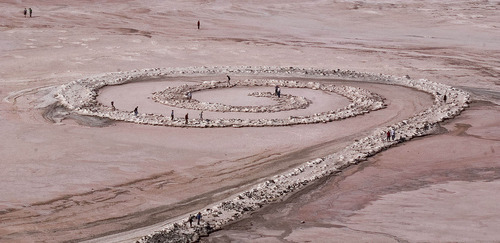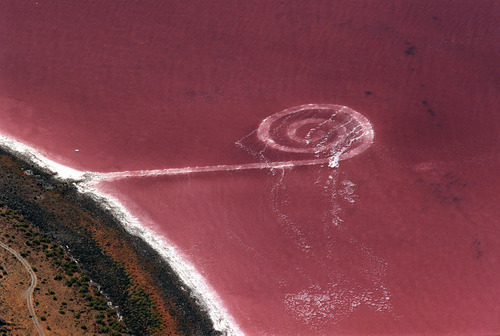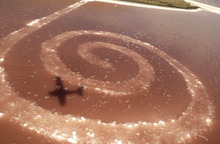This is an archived article that was published on sltrib.com in 2011, and information in the article may be outdated. It is provided only for personal research purposes and may not be reprinted.
A Utah-based group has applied for the lease on Utah's iconic sculpture Spiral Jetty that has been in dispute since an agreement between the New York-based Dia Foundation and the state ended this spring.
The Jetty Foundation is headed by Brigham Young University graduate and former Utahn Greg Allen, a former technology entrepreneur, art collector, filmmaker and art blogger living in Washington, D.C. The group, which was founded in June, includes former KSL-TV news director and Travel Council spokesman Spence Kinnard, Allen said.
Allen doesn't want to compete with Dia Foundation over the land art located at Rozell Point in the Great Salt Lake, but wants to ensure the Utah Department of Natural Resources has a solid option if it fails to reach a new agreement with Dia.
"We wanted to offer a real, viable, alternative," Allen said. "If the Dia deal doesn't work out, this would be a responsible alternative. I don't want a bidding war, I'm not angling to increase Dia's lease costs."
DNR maintained that Dia had failed to renew the 20-year lease when it ran out in February. But Dia countered that it has "promptly paid every annual Spiral Jetty lease invoice, up to and including one sent out by the Department of Natural Resources in February 2011." Dia claims its staff was negotiating the lease renewal with former state Sovereign Lands Coordinator Dave Grierson, who died in 2010.
The DNR now is tracking down the communications between Dia and Grierson and trying to determine what the official's intent was, said department spokesman Jason Curry.
The "process with the state is moving along quite well," said Katie Sonnenborn, Dia's director of external affairs, on Friday.
When the DNR will make a final decision is unclear. "We haven't even talked about a timeline," Curry said. "But nothing has changed as far as land management."
It will be up to the DNR director to decide if the lease is continued with Dia, offered to another applicant or put up for bid.
"Some [decisions] are done case-by-case," Curry said. Going to competitive bids would involve the state's Resource Development Coordinating Council in the process.
He also said a third application for a lease has also been accepted, but wouldn't give details beyond that it was from a Utah applicant.
Heavy spring runoff has again submerged the Spiral Jetty, the world-famous iconic work of land art created by artist Robert Smithson in 1970. The 1,500-foot coil of black basalt rock, earth and salt crystals located in the northern end of the Great Salt Lake, was submerged within two years of its completion, and resurfaced in 2002.
Meanwhile, a peripheral legal dispute over the Spiral Jetty appears to be reaching resolution. Dave Cole, of Salt Lake-based Epic Brewing, says that he has reached an agreement in principle with Dia to use a photograph of the artwork on Spiral Jetty IPA beer. The Dia, claiming copyright infringement, had demanded Epic cease production of the beer, but Sonnenborn confirmed that Dia is optimistic a deal will be reached with Epic.
Cole says Dia was negligent in allowing the Spiral Jetty lease to lapse, but states he is delighted with the new Spiral Jetty Foundation's application for the lease. "This is cool that it's a Utah native group involved," Cole said. "There would actually be somebody legitimately concerned about that artwork."
Allen says he can understand the DNR's disorientation in dealing with the Spiral Jetty.
"In sympathy with them, it's a fairly extraordinary situation," he said. "They are set up for things like oil bids and birds and water— but a site-specific artwork? There is a certain level of absurdity that has to be acknowledged."
If the Jetty Foundation gains control of the land underneath the Spiral Jetty, "the next major step is to sit down with the Dia and the artist's estate and work out what the Jetty's real needs are," Allen said. "They are still the primary stewards of the work and have a history that needs to be built upon."







